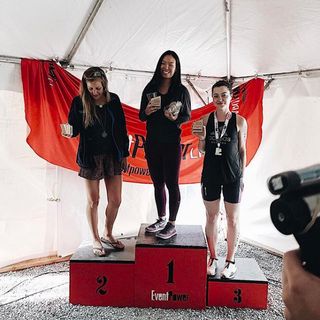True Story: I Eat 3000 Calories Per Day to Stay in Shape
Nicole Loher is a triathlete, Adidas ambassador, and all-around fitness guru, all while balancing a badass day job in the fashion industry (and several side gigs to boot). Needless to say, she’s an inspiration in the art of hustling—and she’s totally game to share her knowledge. Follow her column Part-Time Athlete for her expert advice on everything from establishing a training regimen to finding early-morning gym motivation. Below she shares the drastic changes she made to her diet to get her body in racing shape.

We know this scenario so well: Deciding to “lose weight” or “tone up,” getting a gym membership, tossing all the “bad stuff” from cabinets and fridges, and becoming obsessed with eating as “clean” as possible—most times never maxing out over 1000 calories a day.
I’ve been there too. Many times. It was until after my first triathlon racing season that I realized how undernourished my body was. I was always cold and tired, every workout felt like I put my muscles through the ringer, and it seemed like I was almost always sick. The problem, which didn’t feel like a problem at the time because I was doing as I had always done, was that I was eating about 1200 calories a day. And if we’re being quite honest, the food I was eating wasn’t really even nutrient-dense. My body was burning energy, and subsequently calories, like a furnace—but I wasn’t giving it what it needed to perform. Talk about a recipe for disaster.
It took opening up to a friend who has worked in the fitness world for many years about my chronic tiredness and inability to push past a certain point in my training to understand that I just needed to eat more. Like many women, I grew up with extreme self-confidence issues and a perception that I needed to be thin to be “worth” anything in society.
Initially, the idea of eating more terrified me. But I knew there was only one way out of the blunder I had gotten myself into: to simply eat more. I worked with a guide to help put a plan in place, falling back on counting macronutrients, first upping my 1200 calories a day to 1300 calories a day for a few weeks until my body adjusted, and adding more nutrients in until ultimately I was consuming 2500 calories a day.
Yes. I said it. Today and every day, I eat roughly between 2500 and 3000 calories a day.
So how do you know how much you’re supposed to eat in a given day? “We’ve all heard of hitting the wall,” says Ted Munson, MSc, performance nutritionist at Science in Sport. “This is basically when our glycogen (carbohydrate) stores (the fuel we use during high-intensity exercise) deplete past a certain level. This is a sure sign that we’re not adequately fueling or recovering.”
If you’re interested in understanding the exact science of pinpointing how many calories you should eat in a day, you must know two things: your basal metabolic rate (aka BMR) and your activity factor. Your BMR is an estimate of how many calories you’d burn if you were to do nothing but rest for 24 hours. It represents the minimum amount of energy needed to keep your body functioning, including breathing and keeping your heart beating. You can find this number by having an InBody test run on you at your local gym.
Your activity factor is how much you burn from exercise on average. You can find this by wearing a heart rate monitor or watch while working out. The total of both your BMR and activity factory is your Your total daily energy expenditure (or TDEE), or how many calories you burn per day when exercise is taken into account.
To give an example: Through taking an InBody test, I know my BMR is 1400 and because I work out consistently enough to burn 1100 calories a day, six days a week, I can calculate my TDEE is 2500. Once I was able to figure this out, it made fueling my body as an athlete for performance so much more effective. Once I started fueling my body like an athlete, I started performing like an athlete—placing in most of the races I set out to compete in, and most recently placing third at the Mighty Man Montauk Triathlon with a personal best of two hours and 37 minutes.

Feeling a little overwhelmed? Take baby steps, says Munson. “For someone just getting their feet wet, focus on your macronutrient intake,” he says. “Get the food plate right. An intense day of training should include meals that are over 60% carbohydrates, 30% protein, and 10% fats. A light training day should be predominantly vegetables, with around 40% carbohydrates—simply because they may not be being used.”
Equally, take a step back to focus on things you likely already have in heavy rotation in your life—coffee, hydration, and protein. “Why not use the benefits of caffeine (decreased perception of fatigue) around or during your training session? For protein, if you’re unsure, have a look at the ACSM guidelines. Does your protein intake fall between 1.4 grams to 1.8 grams per kilogram of body mass? There’s even evidence that if you’re injured and undergoing an energy-restricted diet that you should consume even more protein!”
I’d love to hear how you’re reconsidering your nutrition and if how nutrition affects performance interests you. Until then, be well.
Disclaimer
This article is provided for informational purposes only and is not intended to be used in the place of advice of your physician or other medical professionals. You should always consult with your doctor or healthcare provider first with any health-related questions.

